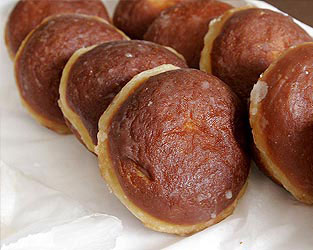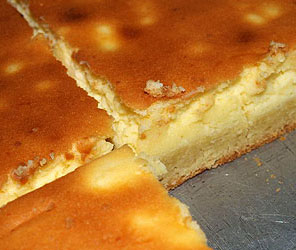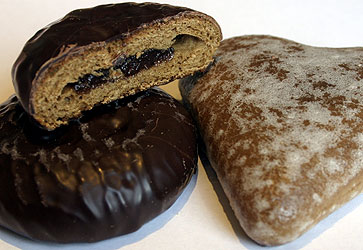Post by Bonobo on Jun 19, 2011 14:52:39 GMT 1
www.tastingpoland.com/food/polish_food_desserts.html
Here comes a list of modern and traditional Polish desserts and sweets. Under descriptions you can find some authentic recipes. Going to visit Poland and would like to taste some delicious foods not choosing on spec? You are welcome. All Polish foods listed below constitute a typical Polish menu up to this days. Therefore, while visiting Poland, one will certainly come across many of them. I wish you good luck in exploring Polish tastes and… Smacznego!
Paczki • Polish donuts
Paczki are one of the most typical sweet snacks you can buy in a Polish store. Paczki are a round spongy yeast cake stuffed with one of many fillings like: rose or strawberry preserves, liqueur, budyn (Polish pudding/blancmange, see below), sweet curd cheese or chocolate. This Polish dessert is fried on deep oil until dark golden color and served covered with powdered sugar, icing sugar or chocolate. Also, oftentimes sprinkled with orange peel. Paczki are one of the most traditional Polish desserts; they appeared in Poland during the time of King Augustus III of Poland (first half of 18th century). A word paczki is plural, its singular equivalent is paczek.
In Poland, there is a strong and pleasant tradition of eating paczki on last Thursday of the carnival. This day is a so-called 'fat Thursday' ('tlusty czwartek' in Polish language). Statistically, every year the Poles consume 100 million paczki in a course of this one day only. A superstition exists, that if anyone do not eat a single one paczki they will be unlucky all year long. In the past a baker who had prepared paczki, impaled some with an almond or a nut. The Poles believed that the one who will find it is going to be lucky in his / her life.
Polish 'Fat Thursday', which is a Thursday before Ash Wednesday, should not be confused with a so-called 'Fat Tuesday'. Fat Tuesday, better known as Mardi Gras is a tradition cultivated in Belgium, Netherlands, Sweden and some parts of United States and Canada. Interestingly Fat Tuesday is also known in Germany, and in the same time Germany is the only country that shares the tradition of Fat Thursday with Poland

Sernik • Cheesecake
Cheesecake is one of the most popular desserts in Poland. A sweet curd cheese is its main ingredient. There are many kinds of sernik differing in composition, taste and the way of preparing. The best known is a cheesecake baked in the oven and made on a layer of a crumbly cake although there are also cheesecakes prepared without baking. In most cases raisins, fruits, a crumble topping or chocolate sauce are typical additions. Quite an original example of this Polish dessert is a delicious sernik made from a sponge cake and cream cheese, and covered with fruit and jelly. This type of cake is dished up cold.

Makowiec • Poppy-seed cake / Poppy-seed loaf
Poppy-seed cake known also as a poppy seed loaf is a traditional Polish dessert - a yeast cake stuffed with a minced poppy. Some raisins, almonds or walnuts are the most typical additions. Baked cake is decorated with icing and (usually) orange peel.
In the distant times the poppy-seed cake was a traditional dessert prepared for Easter and Christmas. In the Christian tradition poppy, containing thousand of seeds in one poppy head, is a symbol of harvest and fertility. Therefore, in the past the Poles and other Slavs believed that eating poppy-seed cake during holidays will bring some luck in their life.

Piernik • Gingerbread
Gingerbread is a well-known aromatic cake with a very intense characteristic taste. It is a little hard and has a dark-brown color. This Polish cake is made from wheat and rye flour, milk, eggs, caramelized sugar and honey. Cinnamon, ginger, cloves, cardamom, nutmeg, anise and lavender are usually used as an addition. In Poland, piernik is sold in a form of a big piece of a cake, or as a package of small cookies usually covered with chocolate and filled with fruit preserves, nut mass or marzipan.
The gingerbread was a traditional cake of Hanseatic cities. Hence it is known not only in Poland, but also in Germany, Netherlands, Russia, whether in Scandinavian countries. Piernik become popular in 18th century in Poland and, just like in other countries, at the beginning was a symbol of prosperity and a high social status. This luxury character of the dessert was a consequence of very high price of spices. Although gingerbread is normally considered a dessert, crumbled piernik is an ingredient of a traditional Old Polish grey sauce.

Here comes a list of modern and traditional Polish desserts and sweets. Under descriptions you can find some authentic recipes. Going to visit Poland and would like to taste some delicious foods not choosing on spec? You are welcome. All Polish foods listed below constitute a typical Polish menu up to this days. Therefore, while visiting Poland, one will certainly come across many of them. I wish you good luck in exploring Polish tastes and… Smacznego!
Paczki • Polish donuts
Paczki are one of the most typical sweet snacks you can buy in a Polish store. Paczki are a round spongy yeast cake stuffed with one of many fillings like: rose or strawberry preserves, liqueur, budyn (Polish pudding/blancmange, see below), sweet curd cheese or chocolate. This Polish dessert is fried on deep oil until dark golden color and served covered with powdered sugar, icing sugar or chocolate. Also, oftentimes sprinkled with orange peel. Paczki are one of the most traditional Polish desserts; they appeared in Poland during the time of King Augustus III of Poland (first half of 18th century). A word paczki is plural, its singular equivalent is paczek.
In Poland, there is a strong and pleasant tradition of eating paczki on last Thursday of the carnival. This day is a so-called 'fat Thursday' ('tlusty czwartek' in Polish language). Statistically, every year the Poles consume 100 million paczki in a course of this one day only. A superstition exists, that if anyone do not eat a single one paczki they will be unlucky all year long. In the past a baker who had prepared paczki, impaled some with an almond or a nut. The Poles believed that the one who will find it is going to be lucky in his / her life.
Polish 'Fat Thursday', which is a Thursday before Ash Wednesday, should not be confused with a so-called 'Fat Tuesday'. Fat Tuesday, better known as Mardi Gras is a tradition cultivated in Belgium, Netherlands, Sweden and some parts of United States and Canada. Interestingly Fat Tuesday is also known in Germany, and in the same time Germany is the only country that shares the tradition of Fat Thursday with Poland


Sernik • Cheesecake
Cheesecake is one of the most popular desserts in Poland. A sweet curd cheese is its main ingredient. There are many kinds of sernik differing in composition, taste and the way of preparing. The best known is a cheesecake baked in the oven and made on a layer of a crumbly cake although there are also cheesecakes prepared without baking. In most cases raisins, fruits, a crumble topping or chocolate sauce are typical additions. Quite an original example of this Polish dessert is a delicious sernik made from a sponge cake and cream cheese, and covered with fruit and jelly. This type of cake is dished up cold.

Makowiec • Poppy-seed cake / Poppy-seed loaf
Poppy-seed cake known also as a poppy seed loaf is a traditional Polish dessert - a yeast cake stuffed with a minced poppy. Some raisins, almonds or walnuts are the most typical additions. Baked cake is decorated with icing and (usually) orange peel.
In the distant times the poppy-seed cake was a traditional dessert prepared for Easter and Christmas. In the Christian tradition poppy, containing thousand of seeds in one poppy head, is a symbol of harvest and fertility. Therefore, in the past the Poles and other Slavs believed that eating poppy-seed cake during holidays will bring some luck in their life.

Piernik • Gingerbread
Gingerbread is a well-known aromatic cake with a very intense characteristic taste. It is a little hard and has a dark-brown color. This Polish cake is made from wheat and rye flour, milk, eggs, caramelized sugar and honey. Cinnamon, ginger, cloves, cardamom, nutmeg, anise and lavender are usually used as an addition. In Poland, piernik is sold in a form of a big piece of a cake, or as a package of small cookies usually covered with chocolate and filled with fruit preserves, nut mass or marzipan.
The gingerbread was a traditional cake of Hanseatic cities. Hence it is known not only in Poland, but also in Germany, Netherlands, Russia, whether in Scandinavian countries. Piernik become popular in 18th century in Poland and, just like in other countries, at the beginning was a symbol of prosperity and a high social status. This luxury character of the dessert was a consequence of very high price of spices. Although gingerbread is normally considered a dessert, crumbled piernik is an ingredient of a traditional Old Polish grey sauce.

























